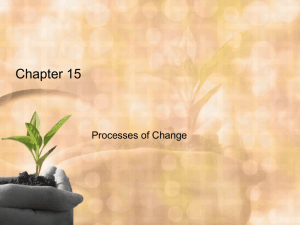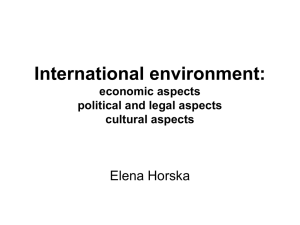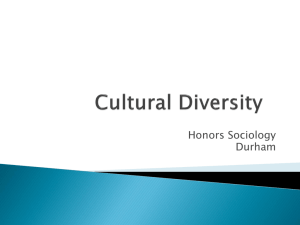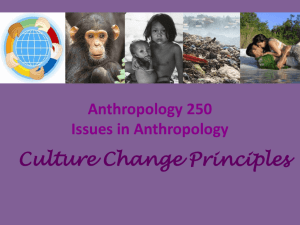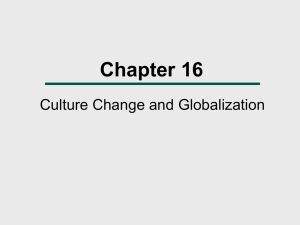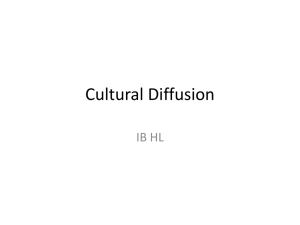0495810843_246863
advertisement
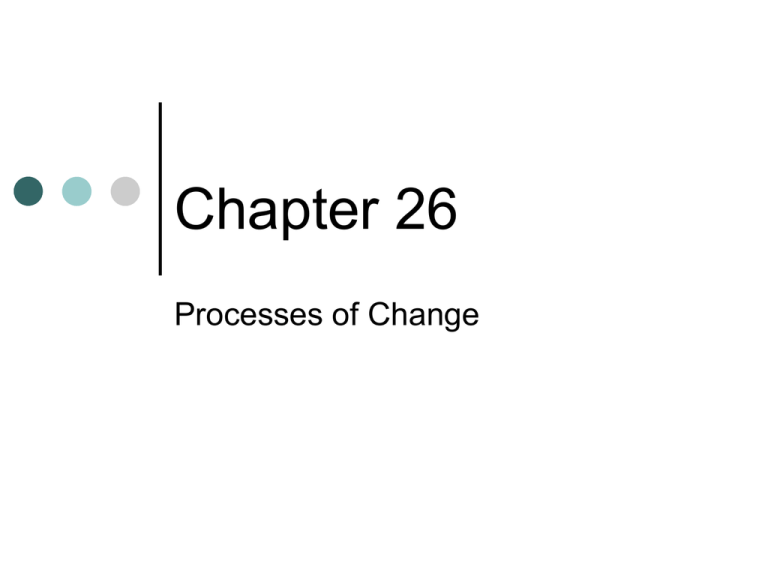
Chapter 26 Processes of Change Chapter Preview Why Do Cultures Change? How Do Cultures Change? What Is Modernization? Why Do Cultures Change? All cultures change. Some changes may be unforeseen, unplanned, and undirected. Changes will result in existing values and behavior changes. This may even involve the massive imposition of foreign ideas and practices through conquest of one group by another. How Do Cultures Change? The mechanisms of culture change include all of the following: Innovation Diffusion Cultural Loss Acculturation/Ethnocide Genocide Directed Change Innovation This is the ultimate source of change in all societies. Innovation is any new idea, method, or device that gains widespread acceptance in the society. Can be primary innovation- chance, discovery, or invention of completely new idea, method, or device. Can also be secondary innovation- a deliberate application or modification of an existing idea, method, or device. Diffusion Diffusion is the spread of ideas, customs, or practices from one culture to another. Cultures that are geographically close in proximity are known to have a lot of diffusion between them. Travel, trade, modern communication can all help diffusion to occur and slowly change certain aspects of a culture. Cultural Loss When cultural loss occurs or the abandonment of an existing practice or trait it can often be replaced with a new practice or technology. This replacement can result in cultural change, although not all cultural losses result in a replacement. If a trait is lost and not replaced it can hinder a cultures growth and thus still causing a change. Repressive Change: Acculturation and Ethnocide Massive culture change that occurs in a society when it experiences contact with a more powerful society is known as acculturation. This can lead to a forced change (often ethnocide) or change by power alone. In other words the change is inevitable because the stronger culture will “force” change onto the weaker culture.3 Ethnocide & Genocide Not all acculturation is violently forced as mentioned. However ethnocide is certainly a violent eradication of an ethnic groups cultural identity. May include the killing of people which is better known as genocide- the physical extermination of people by another outside group. Hitler's Germany Nazi regime is the most well known example of genocide. Directed Change Genocide and ethnocide are not focused on “change” rather eradication of a group of people. Directed change can often be seen when colonial entities attempt to “help” indigenous peoples. Often these powerful forces do not handle or assist the weaker groups in a positive way, whether their intentions were good or not. Due to a lack of understanding of native cultural practices and life ways. Response to Repressive Change Inevitably there is some type of response of indigenous peoples to the changes that have been thrust upon them Two documented responses to this type of change are tradition and syncretism. Tradition & Syncretism Tradition- the customary ideas and practices passed down from generation to the next, which in a modernizing society may form an obstacle to new ways of doing things. Syncretism- in acculturation, change is the creative blending of indigenous and foreign beliefs and practices into new cultural forms. Trobriand Islanders embracing European Cricket with their own style is a great example of syncretism. Revitalization Movements As discussed in the chapter on religion and spirituality, revitalization movements can be used as a mechanism of change. Most commonly a reaction to repressive change- cargo cults are an example of this. Rebellion and Revolution If societal discontent reaches its boiling point one can witness rebellion and or revolution. Rebellion Organized armed resistance to an established government or authority in power. Revolution Radical change in a society or culture. In the political arena, it refers to the forced overthrow of an old government and establishment of a completely new one. Conditions for Rebellion and Revolution Factors that lead to resistance or overthrow of government: 1. Loss of prestige of established authority. 2. Threat to recent economic improvement. 3. Indecisiveness of government. 4. Loss of support of the intellectual class. 5. A leader or group of leaders with enough charisma or popular appeal to mobilize the population against the establishment. Modernization Modernization is the process of cultural and socioeconomic change, whereby developing societies acquire some of the characteristics of Western industrialized societies. This process can be best understood by looking at the five sub processes of modernization. Subprocesses of Modernization 1. 2. 3. 4. 5. Technological development Agricultural development Urbanization Industrialization Telecommunication Globalization The western view has held that nonwestern societies should be able to reach and maintain a level of living close to that of westerners. The reality is that the global population can not consume at the rate of westerners. A depletion of non-renewable resources will be inevitable and quick.
